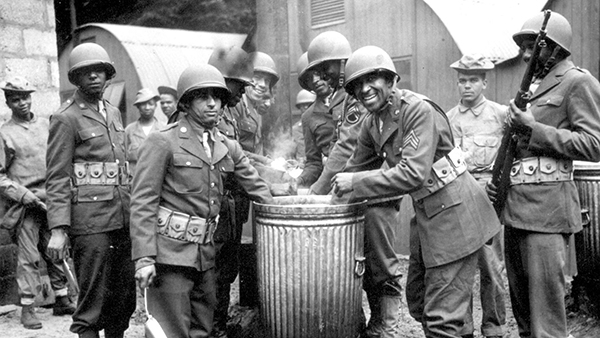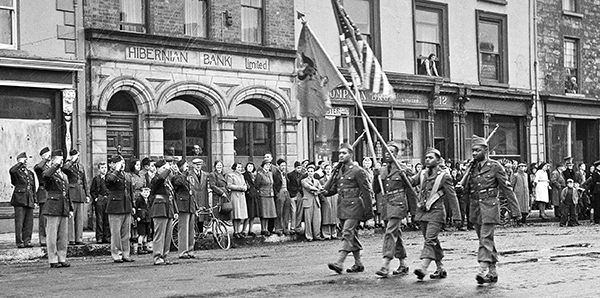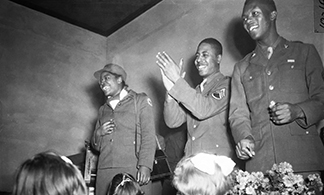‘DUSKY DOUGHBOYS’—AFRICAN-AMERICAN SOLDIERS IN NORTHERN IRELAND DURING THE SECOND WORLD WAR
Published in Features, Issue 2 (March/April 2022), Volume 30By Simon Topping
The sign in Bessbrook, Co. Armagh, was clear—‘Dance for the Blackmen’—yet when some African-American troops arrived they were refused entry, to their dismay. This seeming importation of American ‘Jim Crow’ racial segregation was, in fact, an encounter with Northern Ireland’s particular idiosyncrasies, as, unknown to the soldiers, the Blackmen were a Protestant ‘loyal order’ (the Royal Black Institution) and the dance was for its members. This possibly apocryphal story reveals the complexities that African-American troops brought to Northern Ireland, starting with Anglo-American discussions about even sending them, their relations with locals—often encapsulated in fears about euphemistic ‘Brown Babies’—and frictions between black and white American troops.
In late January 1942, barely a month after Pearl Harbour, the first of 300,000 Americans who would pass through Northern Ireland disembarked at Belfast’s Dufferin Quay. This ‘friendly invasion’ peaked at 100,000 in early 1944, with almost all departing by D-Day. In June 1942 the first African-American troops arrived, and the Dungannon Observer commented that they ‘created the utmost interest. They strike observers as being exceedingly competent.’ Segregated, limited largely to non-combat roles and habitually discriminated against by their commanders and white colleagues, perhaps 12,000 African-American troops served in Northern Ireland.
SEGREGATION NOT ENFORCED
The British authorities lobbied against accepting African-American troops; when the US insisted, London debated whether to institute a ‘colour bar’ mimicking American segregation. This was mirrored in Northern Ireland, with Minister for Commerce Sir Basil Brooke, responsible for managing the Americans, vaguely noting in his diary ‘the difficulties’ of ‘the Coloured question’. He would, however, follow London’s lead, albeit with some latitude afforded by Stormont’s devolved status. The guidance was often ambiguous, and many officials, Brooke included, appear to have been reluctant to commit much to paper; ultimately, however, they rejected a formal colour bar. The Home Office emphasised to Brooke that discrimination was not government policy and that he should ‘ensure that the police do not make any approach’ to business owners ‘with a view to discriminating against coloured troops’. That said, if the Americans introduced informal segregation, that was their choice; nonetheless, ‘the police should not make themselves in any way responsible for the enforcement of such orders’. Thus segregation would not be enforced but could be conveniently ignored if imposed by the Americans themselves.

Above: African-American US Army soldiers draw rations at the camp cookhouse at their station in Northern Ireland in August 1942. Detachments of African-American servicemen were among the first arrivals of US forces in Northern Ireland. (NARA)
If white Americans brought glamour, this was enhanced among African-Americans, as few locals had encountered black people before. A Belfast woman wrote to Eleanor Roosevelt, declaring:
‘… the excitement must be intense in these little places when Negro troops—people they have for the most part never laid eyes on!—arrive in their midst. I am afraid that there may be trouble ahead—for the young girls will undoubtedly walk out with these strangers in a way which will not surprise the local inhabitants who will wish to be friendly, but they will infuriate your own troops.’
And so it proved.
‘THE GIRLS OVER HERE ARE RIGHT IN THERE’
African-American troops were generally popular. One wrote home: ‘the Irish people treat us just as if we were Irish. Before we came here there wasn’t any coloured people … The girls over here are right in there, if you dig what I mean.’ Two others recorded how ‘all the girls are going crazy about us’ and ‘I am loaded down with these Irish girls’. This positivity was not universal, with a soldier complaining anonymously to Stormont about ‘so much segregation, prejudice and strife’. Certain bars were segregated in Antrim, while in Belfast ‘we are insulted, they use the words, N****r and Darky, these are two words that we hate’. British soldiers and sailors had called his comrades ‘Black Bastards [and] son-of-bitchs [sic]’. Interestingly, he believed that this language and racism had been introduced by white Americans, ignoring centuries of British racism. Carrickfergus, however, ‘we like, because when we visit there we are treated like human[s]’. The police reported that ‘the coloured US troops get on well with the British but the fact that they mix well does not tend to help relations between our troops and the other Americans who do not fraternize with the Negroes at all’. African-Americans’ good relations with British troops therefore heightened racial tensions within US forces and feuding between British and white American troops.
The unionist press welcomed African-American troops (the nationalist press mostly ignored the Americans), but often pandered to stereotypes about their being musical, childlike and superstitious, even quoting these ‘Dusky Doughboys’ in their apparent dialect. The Belfast Telegraph, for example, praising a choir, stated that ‘if you pick up four coloured men … in 90 cases out of a hundred you have a singing quartet’. The writer did at least try to understand African-American music in its cultural and historical context, noting that it was a response to slavery’s inhumanity.
UNOFFICIAL SEGREGATION
The US military unofficially enforced segregation, mostly to prevent antagonism within its ranks, while privately admitting that this was caused almost entirely by white GIs. Sometimes this was devolved to enlisted men, including a ‘Good Conduct Committee’ of NCOs created in August 1942. This endorsed segregation and stipulated that where interaction was unavoidable, such as at Red Cross Clubs, ‘then the races should avoid intermingling’. Where both races were invited to parties by girls, they ‘should emphatically inform the girls that mixing of races at parties is not advisable and all soldiers should discourage invitations which lead to mixed parties’. It also declared that neither race should ‘cut-in’ on the other at dances. Eventually two ‘coloured’ Red Cross Clubs were opened, at Antrim’s Protestant Hall and in Bedford Street in Belfast. Another way of avoiding conflict was to have specific nights in towns for each race, for example in Cookstown and, after ‘serious trouble’, Magherafelt—a rule enacted throughout the UK. Stormont only discovered the policy via its hospitality committees.

Above: Soldiers from the 2nd Battalion, 28th Quartermaster Regiment, passing in review on James Street, Cookstown, in October 1942. The officer on the right (obscured by his salute) is African-American, which is unusual. Black units were led largely by white officers, especially at this point in the war, while most African-American officers were chaplains. (NARA)
The US consul in Belfast reported interracial friction as early as May 1942, claiming that it was entirely predictable. African-American sailors and white troops had clashed in Londonderry, as ‘our troops objected to the American Negroes dancing with the Irish girls’. The solution was a separate dancehall for African-American personnel. Segregation, he said, shocked locals, who were ‘disposed to treat all American soldiers, whether white or black, without discrimination’. The correspondence of white Americans, however, bristled with racist hostility, especially regarding dating. It was ‘necessary to lay down the law to the Irish and the coons’, declared a white lieutenant. A quartermaster commented that girls’ preference for African-American troops ‘irks the boys no end … No doubt there will be some bloodshed in the near future.’ One soldier stated that Southerners ‘want to go out and carve up the colored boys immediately. The civil war has started among the American troops in Ireland.’ Another warned: ‘wait ’til Georgia gets those educated Negroes back there’, predicting the lynching of African-American veterans after the war.
This hostility resulted in murder in Antrim in August 1942, when Private William Jenkins was shot by Military Police and his body handcuffed to railings. When his comrades found him, with the hallmarks of a lynching, they wounded an uninvolved white soldier before order was restored. Bob Fawcett, a teenager at the time, remembered the evening in vivid detail, hearing gunshots and the police ordering people indoors. He also recalled a light-hearted incident in which his family was awoken by breaking glass; an African-American soldier, fleeing from MPs, had crashed through their low living-room window in the blackout, thinking it was an alley. The soldier dutifully returned, paying for the damage and compensating Fawcett’s father with a bottle of whiskey.

Above: Miss Mary L. Divers, Handley, West Virginia, American Red Cross (ARC), addresses the audience at an ARC dance in Cookstown on 30 October 1942. On her right are S/Sgt Clarence M. Patterson, Dayton, Ohio, and S/Sgt Augustus M. Grant, Charleston, South Carolina. (NARA)
There were conflicts, usually brawling, between African-Americans and locals, and in March 1944, near Belfast’s York Road, Pte Wiley Harris stabbed Harry Coogan to death in a drunken dispute over money for a prostitute. Coogan struck Harris first, but Harris’s vicious retaliation was deemed premeditation by his court martial, and he was executed in May. The Belfast press and civilian court-martial witnesses did not emphasise his race; they did refer to him as ‘the coloured soldier’ but, equally, simply as ‘the soldier’ or ‘the American’. By contrast, the American authorities, including his defence counsel, stressed race, and the review confirming the death sentence expressed racist attitudes about oversexualised black men threatening white women. Under the 1942 Visiting Forces Act, London, and by extension Stormont, ceded criminal jurisdiction to the Americans. Asked to intervene, Brooke, now prime minister, conceded that a local court might have ‘exercised the prerogative’ but he was powerless. Locals recognised the racial dimension. Belfast’s coroner warned his jury to ignore ‘the fact that a white man had been stabbed by a coloured man’, while a ‘Loyal and Law-Abiding Citizen’ suggested to Brooke that the court might have spared a white soldier. That eleven of eighteen Americans executed in the UK were African-American indicated that he had a point. The case lingered. John Campbell, then a child in York Road, recalled hostility towards African-American troops, with women closing their doors if they approached and children being wary, whereas white Americans lived up to their ‘any gum, chum?’ reputation.
Witnessing racial discrimination did not alter Northern Ireland’s own ‘Jim Crow’ system. Unionists ignored the obvious analogies, while African-Americans and Catholics did not equate their respective oppression; Catholics were ostensibly hostile to these American ‘occupiers’. One African-American soldier, after a priest asked whether he was Catholic, did recognise sectarian and racist undercurrents, responding: ‘Holy snakes, no, it’s bad enough being a Negro in Ulster’. Police reports nevertheless accentuated the positive, noting that ‘coloured troops also get on well with all sections of the community’.
Crucially, African-Americans were ultimately welcomed to the UK because they would not be staying. As the war wore on, however, historians argue that British racism, likely echoed in Northern Ireland, became more evident. African-American troops nevertheless caught a glimpse of a society without segregation; as one sailor, returning to Belfast 50 years after the war, reflected: ‘The Irish people didn’t look on us as our skin color, they looked on us as Americans—American fighting men’.
Simon Topping is Associate Professor of United States History at the University of Plymouth and the author of Northern Ireland, the United States and the Second World War (Bloomsbury, 2022).
Further reading
B. Barton, Northern Ireland in the Second World War (Belfast, 1995).
M.P. Kelly, Home away from home (Belfast, 1994).
G. Smith, When Jim Crow met John Bull: black American soldiers in World War II Britain (London, 1987).
S. Topping, ‘The Dusky Doughboys: interaction between African American soldiers and the population of Northern Ireland during the Second World War’, Journal of American Studies (Autumn 2013), 1131–54.
















